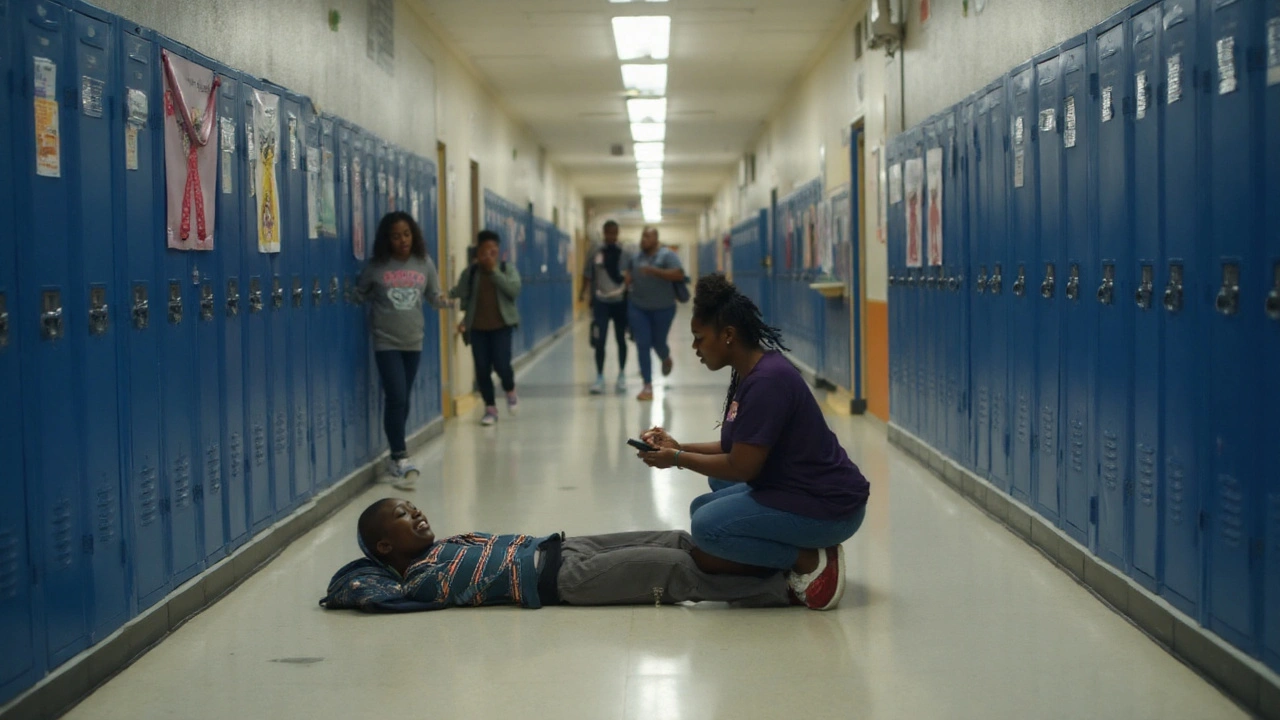When a child on the spectrum stares off, stiffens up, or drops to the floor, parents face the same gut question: was that autism, or was that a seizure? You want clear signals, not scary rabbit holes. Here’s the bottom line up front, and then we’ll get practical about what to watch for, what to do, and how to work with your child’s doctor.
- Seizures are more common in autistic kids than in the general population, especially if there’s intellectual disability or a known genetic condition (CDC; AAP).
- Not every “zone-out” is a seizure. Video helps your doctor tell seizures from autistic behaviors like stimming or hyperfocus.
- First aid is simple: time it, keep the airway clear, protect the head, don’t put anything in the mouth, call for help at 5 minutes.
- EEG and, sometimes, MRI are used when events are suspicious or there’s regression. Routine EEG screening isn’t needed for every autistic child.
- Treatment is individualized. Meds, diet, and devices can control seizures; a written action plan keeps school and caregivers aligned.
I’m Dorian. At our house, my partner Elowen and I have had those late-night “what was that?” whispers while our border collie, Rook, watches us like he already knows the plan. You deserve that kind of calm plan too. Let’s build it.
What links autism and seizures-and what that looks like
You’ll hear two terms. “Seizures” are the events you see. “Epilepsy” means a tendency to have unprovoked seizures. In kids with autism, the two overlap a lot, but not always. Across large studies, about 20-30% of autistic people develop epilepsy by adulthood, with two peaks of onset: early childhood and adolescence (American Academy of Pediatrics; International League Against Epilepsy). Risk is higher when there’s co-occurring intellectual disability, developmental regression, or a genetic syndrome like TSC, Rett, or SCN2A-related conditions.
Why the higher risk? Brain networks that manage inhibition and excitation develop differently in autism. Genes that tune brain signaling-think sodium channels like SCN2A or synaptic proteins like STXBP1-can affect social communication and seizure thresholds at the same time (ILAE; AAN genetics guidance). That’s the biology. For you, what matters is pattern recognition and a plan.
Common seizure types you might see:
- Generalized tonic-clonic: sudden fall, stiffening, rhythmic jerking, then deep sleep. Often 1-3 minutes.
- Focal impaired awareness: a brief “pause,” staring, lip smacking, hand movements, or wandering; the child is not fully aware.
- Absence seizures: quick, 5-15 second blank spells with eyelid fluttering; child resumes activity like nothing happened.
- Myoclonic: rapid, shock-like jerks of shoulders or arms, often after waking.
Common non-seizure “look-alikes” in autism:
- Stimming: hand flapping, rocking, vocal sounds; child is aware and can often be redirected.
- Hyperfocus/daydreaming: the child responds if you touch the shoulder or use a favorite cue.
- Tics or stereotypies: brief, repetitive movements that the child can sometimes suppress briefly.
- Sleep myoclonus: jerks while falling asleep; harmless.
Quick reality check: you can’t always tell by watching once. Doctors rely on the story, patterns over time, and-gold standard-a video of the event. If you remember one thing from this section, make it this: record the spell safely and note the clock. That’s the single most helpful data you can bring.
| Topic | Autistic Children | General Population | Notes (authoritative sources) |
|---|---|---|---|
| Lifetime epilepsy risk | ~20-30% | ~1-2% | Higher with intellectual disability (AAP; ILAE) |
| Onset peaks | Early childhood, adolescence | Early childhood varies | Two peaks described across cohorts (ILAE) |
| Febrile seizures | Slightly higher than baseline | ~2-5% of children | Most are benign; discuss with pediatrician (CDC) |
| EEG abnormalities without seizures | Not rare | Less common | EEG alone doesn’t diagnose epilepsy (AAN) |
If you’ve heard scary terms like “regression,” here’s the plain version. A small subset of kids lose language or skills they had. Most regression in autism is not caused by seizures, but certain rare epilepsy syndromes, like electrical status epilepticus in sleep (ESES) or Landau-Kleffner, can drive language loss. If you see new language loss or attention changes over weeks, especially with night twitching, bring it up fast. Your doctor may order a sleep EEG. Acting early helps.
Big myth worth squashing: vaccines do not cause autism or epilepsy. Febrile seizures can happen after fever from many causes, including some vaccines, but they’re brief and not linked to lasting epilepsy risk (CDC; AAP). Skipping vaccines increases the risk of severe infections, which do increase seizure risk.
What about screens and flashing lights? Only a small slice of people with epilepsy have photosensitivity. If flashes trigger your child, your neurologist will test for it on EEG and guide screen settings (ILAE).
One more vocabulary note for your search terms: when people say autism and seizures, most mean epilepsy co-occurring with autism. You’ll also see “epileptiform discharges” (spikes on EEG) even without clinical seizures. Doctors avoid treating the EEG alone unless there are matching symptoms.

How to spot it, respond, and build a plan that actually works
Here’s the field guide I wish every parent got at the first suspicious spell. Keep it simple. Keep it repeatable.
What to capture during a spell (the “T-V-3” rule):
- Time it: look at a clock. Note start and stop (or “still going at 5 minutes”).
- Video it: sideways phone video, whole body in frame, stay safe.
- Three details: awareness (do they respond to name/touch?), movement (stiff, jerking, lip smacks?), color/breathing (blue/pale?).
Seizure first aid (memorize the 5 basics):
- Stay calm and time it.
- Protect the head, clear hard objects, loosen tight clothes.
- Roll to the side when the jerking stops or if there’s drooling/vomit (recovery position).
- Do not put anything in the mouth. Do not restrain the movements.
- Call emergency help if it lasts 5 minutes, it’s the first seizure, there’s injury, breathing doesn’t normalize, or seizures repeat back-to-back.
After a spell: expect confusion or deep sleep for minutes to hours. That’s typical. Let them rest, keep the room quiet, and jot notes while they’re fresh in your mind.
What’s a red flag that needs urgent care today?
- A first unprovoked seizure.
- Any seizure lasting longer than 5 minutes, or a cluster without full recovery.
- Head injury, breathing problems, serious illness, or fever in a very young infant.
- Sudden, sustained language loss or behavior regression over weeks.
How doctors sort this out:
- History + video is king. Pattern (time of day, triggers, recovery) often points to the seizure type.
- EEG looks at brain waves. It’s helpful when the story fits. A normal EEG doesn’t rule out epilepsy; an abnormal one doesn’t always mean epilepsy. Sleep recordings catch more.
- MRI is ordered when there are focal signs on the exam, an abnormal neuro exam, regression with seizures, or if seizures are hard to control.
- Genetic testing gets recommended more often now-especially with early-onset seizures, developmental delay, or dysmorphic features. Findings can guide therapy (AAN; AAP).
Should every autistic child get an EEG? No. Screening EEGs in kids with no concerning events aren’t recommended. Test when the clinical picture suggests seizures, or if there’s regression that worries your clinician (AAN practice guidance).
Treatment options, in plain speak:
- Medicines: levetiracetam, valproate, lamotrigine, oxcarbazepine, ethosuximide (for absence), and others. Fit the drug to the seizure type. Watch for mood effects (irritability with levetiracetam), weight/appetite changes (valproate), or rash (lamotrigine-slow titration). Your neurologist will tailor dosing and monitor labs when needed.
- Diets: ketogenic or modified Atkins can reduce seizures in some kids. They need dietitian support and labs. Hidden benefit: stable routines can help behavior; trade-off: it’s strict.
- Devices: vagus nerve stimulation for tough-to-control seizures; responsive neurostimulation in select cases (older kids/adults). Surgery is considered for focal lesions after a detailed work-up.
- Rescue meds: intranasal midazolam or diazepam for seizures that cross your “too long” threshold, often 3-5 minutes, or for clusters. Keep one at home and at school with clear instructions.
Behavior and meds are a two-way street. Some seizure meds can nudge mood or attention; some ADHD or sleep meds can lower seizure threshold a bit. Good news: most kids do fine with careful choices and slow changes. Bring teachers into the loop so they can flag shifts early.
Triggers you can actually manage:
- Sleep: protect sleep like it’s medicine. Regular schedule, cool dark room, consistent wind-down.
- Illness/fever: treat fever for comfort, offer fluids, and rest. Ask your doctor if a rescue plan changes during illness.
- Missed doses: use pill boxes, alarms, or med apps. For liquid meds, mark the bottle when you give it.
- Stress/sensory overload: predictable routines and quiet decompression time lower the chance of non-seizure meltdowns that get confused with seizures.
Build a Seizure Action Plan (SAP) that real people can follow. One page. Big font. Include:
- What a typical event looks like for your child (2 lines, plain language).
- When to start rescue medicine (for example, “if still seizing at 3 minutes”).
- How to give it (device, dose, step-by-step).
- When to call 911 or parents.
- Contact info and allergies.
Share the SAP with school, after-school programs, babysitters, and grandparents. Walk them through a practice drill once. In our house, we do a goofy “timer and teddy bear” run-through. Rook thinks it’s a game; we think it’s peace of mind.
Home safety tweaks that matter if seizures aren’t fully controlled:
- Baths become showers; no water alone. Keep the bathroom door unlocked.
- Low bed or mattress on the floor; avoid top bunks.
- Soft corner guards, non-slip mats.
- Supervise climbing play. Helmet use for drop attacks if recommended.
Wearables and monitors: take them as add-ons, not guarantees. Some watches and bed sensors can alert to big movements. They’re less reliable for short or subtle seizures. If you use one, still keep the action plan and routine checks.
Heuristics that simplify decisions:
- “3-5 rule”: start rescue med by 3-5 minutes; call emergency at 5 minutes or earlier if breathing is poor.
- “One change at a time”: if adjusting meds, don’t change sleep or diet the same week unless guided-easier to see cause and effect.
- “Video beats memory”: a 30-60 second clip is better than a perfect description.

Testing, treatment fit, school plans, and your next steps
Here’s how to move from worried to organized, based on where you are today.
If you just saw a first suspicious spell:
- Write down the details and save the video.
- Call your pediatrician within 24-48 hours. Ask if an EEG referral makes sense based on what you saw.
- Secure the sleep routine tonight and remove obvious hazards.
- Set your phone with a simple timer app on the home screen.
If you’re in the work-up phase (EEG ordered or pending):
- Ask whether a sleep EEG adds value for your child’s pattern.
- Bring a list of meds/supplements, including melatonin or ADHD meds.
- Note any regression (language, play, attention) with rough dates.
- Ask if genetic testing is appropriate given age of onset and development.
If the diagnosis is epilepsy:
- Clarify seizure type. The name guides the best meds.
- Discuss side effects to watch for and a follow-up schedule.
- Get a written seizure action plan and practice it with school.
- Set a medication routine tied to daily anchors (breakfast and bedtime).
If seizures are still breaking through:
- Track them in a simple diary: date, time, trigger, duration, rescue med used.
- Ask about a dose increase, a med switch, or adding a second med.
- Discuss non-drug options: diet therapy, vagus nerve stimulation, or surgical evaluation if focal.
- Check labs if prescribed meds can affect levels (valproate, carbamazepine) or bone health (vitamin D).
School and IEP tips that make a difference:
- Put the Seizure Action Plan in the IEP/504. Name the adults trained to give rescue meds.
- Agree on a communication protocol: how the school will notify you (call vs. text, what info).
- Arrange a quiet recovery space and a way for your child to transition back to class.
- Build in sleep-friendly scheduling if mornings are fragile after night seizures.
Common pitfalls to avoid:
- Chasing every odd move with a new test. Look for patterns over a few events, then test strategically.
- Stopping a med abruptly. Most anti-seizure drugs need slow changes.
- Letting “normal EEG” stop the conversation. If the spells keep happening, call back. The story matters.
- Keeping the plan in your head. Put it on paper and share it.
Quick comparison: seizure types vs. common look-alikes
| Feature | Likely Seizure | Likely Non-Seizure |
|---|---|---|
| Awareness | Unresponsive to name and touch during event | Responds to touch or a favorite cue |
| Onset/offset | Sudden start/stop, stereotyped pattern | Gradual, can be interrupted or redirected |
| Color/breathing | Pale/blue, irregular breathing possible | Normal color, regular breathing |
| Post-event state | Confusion or deep sleep (post-ictal) | Baseline quickly, no deep sleep |
| Triggers | Sleep deprivation, illness, missed meds | Sensory overload, frustration, transitions |
Mini‑FAQ
- Do fevers cause seizures in autistic kids more often? Febrile seizures are common in childhood and seem slightly more frequent in autism, but most are brief and harmless. Your pediatrician can advise if EEG is needed (CDC; AAP).
- Can absence seizures be mistaken for zoning out? Yes. If your child has frequent brief “blank” spells with eyelid fluttering and no response to touch, ask about a brief EEG with hyperventilation testing.
- Is SUDEP a concern? The risk in children is low, but it’s higher with frequent, uncontrolled generalized tonic-clonic seizures. Best protection is seizure control, med adherence, and sleep hygiene (ILAE).
- Are CBD products a solution? Only prescription cannabidiol has solid evidence for a few epilepsy syndromes; over-the-counter products vary in quality and can interact with meds. Ask your neurologist.
- Can therapy for autism worsen seizures? Behavioral therapies don’t trigger seizures, but fatigue and stress can make spells more noticeable. Balance schedules and build in breaks.
Credible sources behind this guidance: American Academy of Pediatrics clinical reports on autism and co-occurring conditions; International League Against Epilepsy classifications and seizure first aid; Centers for Disease Control and Prevention data on febrile seizures and vaccine safety; American Academy of Neurology practice parameters on EEG and genetic testing; NICE guidance on epilepsy diagnostics and management. If your doctor cites these, you’re in good hands.
Next steps / troubleshooting for different scenarios
- If your child had a first seizure today: seek medical care, save the video, and ask for a clear return-to-activity plan before you leave.
- If events only happen in sleep: request a sleep-deprived or overnight EEG and tighten bedtime routines for the next two weeks while tracking patterns.
- If meds are starting to affect mood: call the prescriber; options include adding vitamin B6 with levetiracetam (discuss dosage), switching meds, or slower titration.
- If school is anxious about liability: provide the signed Seizure Action Plan and request a training session with the school nurse. Keep the rescue med supply current.
- If you’re waiting months for neurology: ask your pediatrician to start the EEG and labs, and to write the action plan and rescue med script now.
You don’t need to become a neurologist. You just need a repeatable routine, a short action plan, and a team that listens. That’s how you turn a scary unknown into something you can handle on a Tuesday afternoon.

May .
September 7, 2025 AT 04:24Sara Larson
September 7, 2025 AT 23:15Josh Bilskemper
September 9, 2025 AT 09:39Storz Vonderheide
September 10, 2025 AT 00:34dan koz
September 10, 2025 AT 16:14Kevin Estrada
September 10, 2025 AT 16:55Katey Korzenietz
September 11, 2025 AT 18:27Ethan McIvor
September 13, 2025 AT 05:23Mindy Bilotta
September 14, 2025 AT 20:21Michael Bene
September 15, 2025 AT 21:46Brian Perry
September 16, 2025 AT 04:21Chris Jahmil Ignacio
September 17, 2025 AT 22:59Paul Corcoran
September 18, 2025 AT 07:01Colin Mitchell
September 18, 2025 AT 20:59Stacy Natanielle
September 20, 2025 AT 02:27May .
September 20, 2025 AT 10:25